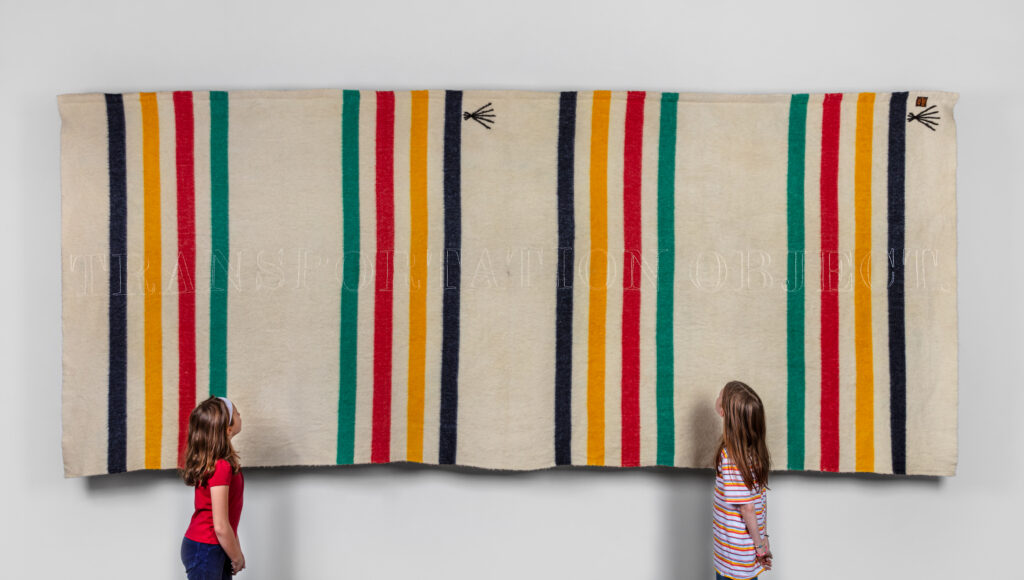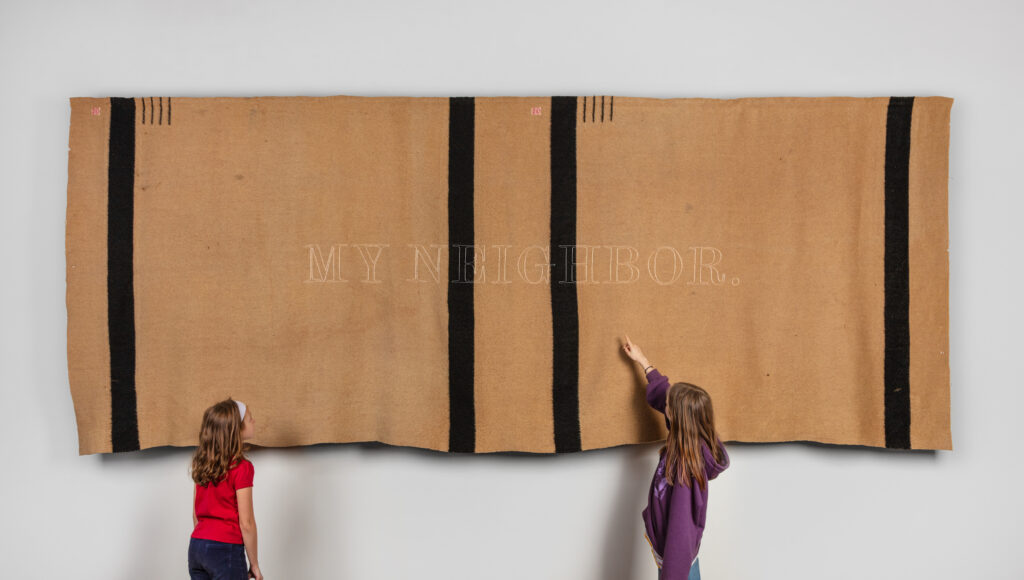When you walk into the room that houses Marie Watt’s LAND STITCHES WATER SKY exhibition, your voice echoes. The 2024 installation by Marie Watt is located in the Carnegie Museum of Art’s Forum Gallery, a smaller room off the museum’s main entryway dedicated since 1990 to a series of installations by living artists.
While the previous Forum series iteration, Amie Siegel’s Panorama, rendered the room pitch-black to show the artist’s film, LAND STITCHES WATER SKY completely opens up the space with some of the whitest walls in the building—the sudden brightness of the space is refreshing and has an airy, exuberant feel to it. Two of Watt’s steel I-beam sculptures, called “quilts,” stand in the gallery center. Quilt (Legendary) and Quilt (Lost Thunder Chorus) make crescent-like arcs through the space, cyclical but not quite circular.

“What’s Going On?”
The echo effect in the room is fitting, because each I-beam quilt has a repeated phrase on it. Brother Brother, Mother Mother, and Step Step Step (stylized in handwriting as step Step STEP). “I was listening to ‘What’s Going On’ by Marvin Gaye where he calls out mother, mother brother, brother sister, sister. I thought about how in an an indigenous way that call goes further, extending this concept of how we are all related,” Watt, who is a member of the Seneca Nation, said. The question of “what’s going on” is simple, both conversational and observational. Gaye’s Motown track, just like Watt’s work, manages to convey both tenderness and seriousness.
So, Watt asked people: “What’s going on?” Through a collaboration with the Pittsburgh Poetry Collective, Watt and a group of participants including local poets, museum educators, and fifth graders generated words related to both Pittsburgh regional identity and generational relationships, all while listening to Gaye’s pleas for unity in “What’s Going On?” (I listened to it on loop while writing this, too, for the record). What appeared were words like Steel Steel, Waste Waste, Family Family, Furnace Furnace, and one of the most striking that appears on its own: Vulnerable. This handwritten etching on its own feels like a key to understanding the “quilts,” which turn the harshness of metal into something soft.
A Personal Touch
Each word is preserved in a participant’s handwriting. “Our handwriting is not so different from our thumbprint,” Watt says. “It’s connected to our body and it’s unique to us.” Curator Liz Park said that “The only rule was to spell it correctly,” which each participant managed to do. The words become incantations or palindromes, part of the visual experience of LAND STITCHES WATER SKY.
One of the strengths of LAND STITCHES WATER SKY is that, despite the many contextual elements to it, on its own, the work has a straightforwardness to it. All of this backstory (the poetry collective, Watt’s inspiration from Marvin Gaye) is merely context for the combination of curiosity and somberness that comes through in Watt’s work. The steel quilt pieces’ central placement in the gallery allows visitors to look at them without wall text when they first enter the space, and there’s something really touching about the handwriting samples on each rectangle of metal that can connect with any viewer, regardless of familiarity with Watt’s practice or with the thinking behind the piece.
Another Kind of Skywalker
During Watt’s childhood, she heard stories of the Seneca ironworkers called “skywalkers.” She then watched George Lucas’s Star Wars in theaters. “There was Luke Skywalker—I felt seen because we had skywalkers in our community, too. It felt validating in some way to see that, an entry point.” This inquiry produced the sculptures in Watt’s Skywalker/Skyscraper, one of which is on view in the permanent collection galleries of the museum.
An idea that arises from LAND STITCHES WATER SKY is that popular culture can be an entry point. Though Star Wars is unlikely to be found in a textbook or a museum, it had the power to make Watt feel seen and to resonate with her. Similarly, “What’s Going On?”, a pop song, generated the conversations that created LAND STITCHES WATER SKY. Inspiration, provocation, and solace are in everything, including elements of ubiquitous popular culture. This resonates with me: there are times when I’ve experienced more personal growth from Netflix shows and pop music than from therapy or academia.
Each of us is a quilt of our experiences and influences, and in a world with so much music, art, literature, and film to choose from, it stands to reason that we can be as inspired by Star Wars as by some more “high culture” artifacts. Watt is also takes an interest in how things like towers occupy a mythic status, but what replaces them now are steel buildings, made up of the small I-beams she and the fabricators at Poki Moto have welded onto. “I hope that these words [in the artwork] are catalysts for conversations for topics that we’re drawn to, but topics that are complicated,” Watt said. Both she and Park agreed that one of the goals for the exhibition was “room for wonder.”

Softness and Strength
Along with the I-beam “quilts,” Watt brought elements of her exhibition concept Blanket Stories to the Carnegie in the form of two double-long wool trade blankets. For Blanket Stories, Watt got friends and acquaintances to donate blankets to create enormous sculptures. When I saw Watt’s blankets installed at the museum, I first did a double take—I knew that white wool Hudson Bay blanket with stripes of teal, scarlet, and yellow on it.
Personal Connections
My partner owns that exact blanket, and I have slept with it many times. I experienced firsthand one of the pleasures of Watt’s work, which is that the objects she uses feel familiar and situate you within the comfort of your own experience in a gallery. Watt explained that the double-long blankets were an example of a “early tax loophole.” The blankets were exported as one blanket, but there were instructions on where to separate them so traders were only taxed for one. As for where she sourced her blankets for LAND STITCHES WATER SKY, Watt laughed and said: “The modern trade network called eBay.”
Though the steel quilts are a hard metal and the blankets are soft, part of Watt’s aim with LAND STITCHES WATER SKY is to show how these two opposing materials can both be large parts of our everyday lives. “Blankets and steel both have an architectural nature — they protect us and envelope us. They’re building and constructing materials, and both are resilient and vulnerable,” Watt said. “Steel is one of the most recycled materials on the planet, in everyone’s home.” A quilt, further, is made up of a patchwork of difference, and Watt manages an incredible feat in making the brittleness of metal feel soft by adding a patchwork of human voices to it.
Looking for more artistic inspiration? Check out our article on how to spend A Day Out at The Frick Pittsburgh’s Vermeer, Monet, and Rembrandt Exhibit.
Story by Emma Riva / Photos Courtesy of Marie Watt
Editor’s note: Emma Riva has worked in the Visitor Services department of the Carnegie Museum of Art.
Subscribe to TABLE Magazine‘s print edition.

